The trumpet holds a significant place as a musical instrument in various genres, from jazz to classical music. In this article, we are going to guide you through different parts of the trumpet, help to understand its anatomy and the way the trumpet sound is produced.
What is the Mouthpiece?
This is the part of the trumpet, serving as the interface between the musician’s lips and the instrument itself. This is also the part where the sound begins, when the player blows into it. Mouthpieces vary in shapes and materials. Mostly they are crafted from brass or silver, although today one can also buy plastic, titanium, and stainless steel alternatives.
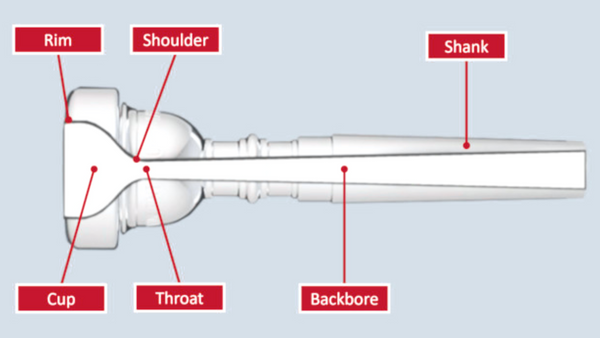
The size, depth and form of the mouthpiece affect the instrument’s tone and projection of the sound. By experimenting with various models, trumpeters fine-tune their sound according to the desired tonal quality.
Mouthpieces consist of a cup, a throat, and a backbore. The cup is the deepest part of the mouthpiece that impacts sound quality. Larger deep cups produce lower, darker sounds, while smaller or shallow cups result in the brightest sounds. For a better stability and vibrant sound, musicians often use mouthpiece boosters. These accessories can improve tonal quality, provide rich overtones and ease the process of taking high notes.
What is the Mouthpiece Receiver?
It is the component located on the lead pipe of the trumpet where the mouthpiece is inserted. It looks like a tube, extending from the instrument's body. This part has a cylindrical or slightly conical form, crafted in a way to securely hold the mouthpiece in place.
The mouthpiece receiver transmits sound vibrations produced by musicians into the instrument, so it impacts the entire sound quality. The design of this part also influences the airflow and the resonance of the sound within the trumpet.
What is the Trumpet Lead Pipe?
The lead pipe is a crucial part of the trumpet that is responsible for channeling the air stream into the main body of the instrument. It helps vibrations from the musician’s lips go through the instrument. The air blown by the musician travels through the lead pipe into the valve assembly and through the tubing.

Its design affects the airflow, resonance, and response, as well as timbre and sound projection. Different lead pipe designs help achieve various sounds characteristics, such as warmth, brightness, or richness. Typically, lead pipes are made from the same materials as the rest of the trumpet. In most cases it’s brass or silver, however manufacturers experiment with different alloys and plating techniques to achieve specific sonic properties. Lead pipes also vary in thickness, taper, and internal shaping.
What are the Valves?
Valves are the components that unlock the full range of notes. They control the airflow through the tubing. Typically, a trumpet has three piston valves, known as the first, second, and third valves. They are aligned in a straight line along the trumpet's length. However, the trumpet can also include additional ones.

By pressing these valves, musicians alter the length of tubing within the instrument, which affects the pitch of the notes. Various combination of valves and fingerings help achieve a rich musical landscape.
Each valve has a cylindrical casing with a piston or valve stem. The piston is located within the casing, helping it to move up and down. The up or open position provides the tubing with an additional length for the airflow, lowering the pitch. The pressed valve in the down position directs the air differently as this position shortens the length of tubing, which results in a higher pitch.
Depending on personal preferences of musicians, the valves can be complemented with trim kits, featuring valve caps and buttons, to enhance the attraction and personalize the trumpet with minimal modifications. This upgrade allows adding fresh touch to the instrument without changing the core functional parts.
What is the Tuning Slide?
The tuning slide is used for adjusting the length of the tubing. Located between the mouthpiece receiver and the main tubing, it affects the pitch of the produced sound.
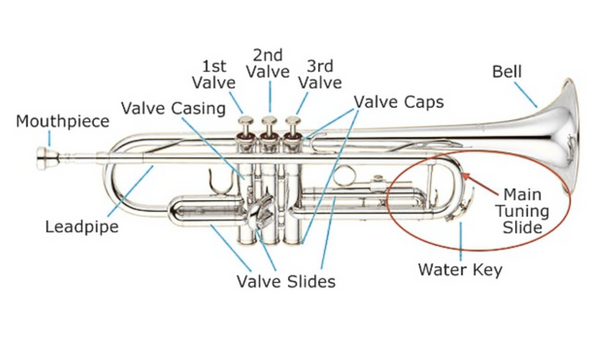
The tuning slide helps the trumpet to sound in tune with other instruments. This part is also crucial for achieving of the proper intonation for solo performance or during playing with ensembles. The musician either push inwards or pull outwards it to adjust the length. Pushing shortens the length and provides a higher pitch. Pulling lengthens the instrument and leads to a lower pitch.
What is the Trumpet Bell?
The bell serves as a distinctive feature and an important component for shaping the sound of the instrument. The bell acoustically amplifies the sound, improving its projection and resonance. The flared shape radiates sound waves, helping them reverberate throughout the trumpet, and effectively projects them into concert settings. The bell also shapes the tone quality and color, affecting the harmonic content.
Made of brass, the bell is attached to the main tubing of the instrument. Its shapes and sizes can vary depending on the model of the trumpet. Larger and open bells result in producing broader and resonant sound. Smaller bells result in more focused, compact sound.
The bell can contain some embellishments or engraved symbols. They don’t influence the sound, however make the instrument more appealing visually. The bell requires proper care and maintenance to provide the trumpet with excellent playability and extend its lifespan, as the accumulated dirt and moisture inside and outside can lead to oxidation and corrosion. As this part is responsible for sound quality and resonance, it’s also important to prevent any physical impact on the bell, by selecting a proper storage place and a suitable trumpet bag for transportation.
What are Trumpet Finger Buttons?
Finger buttons, also known as valve buttons, allow musicians to articulate notes, navigating complex passages with ease. These components, located above each valve casing, help the players maintain control over the instrument and seamlessly express their musical ideas.
Finger buttons serve as a point of contact between musicians’ fingers and the instrument, directing airflow through the desired valve combination. Rounded in shape and crafted to fit fingers size, they provide quick movement and comfortable contact while pressing and releasing.
Finger buttons are made of brass, nickel silver, and synthetic materials. Despite their small size, they really affect the visual appeal of the trumpet. For instance, one can complement your trumpet with finger buttons with natural stones. Although such customization may minimally influence sound, the tactile experience and visual impression can really boost the musician’s confidence and make the connection to their instrument stronger.
Final Word
Each part of the trumpet, including the mouthpiece, valves, tuning slide, the lead pipe and bell contributes to shaping tone, projection, and articulation. By understanding the anatomy of the trumpet, musicians can unlock the full potential of the instrument and effectively express their emotions through performances. With multiple interesting options for visual upgrade and improvement of sonic characteristics, it’s possible to find your own voice and make your trumpet more personalized.
If you’re interested in making your trumpet unique, you can learn about basic accessories for this purpose here.
Stay tuned. We’re preparing more helpful articles.

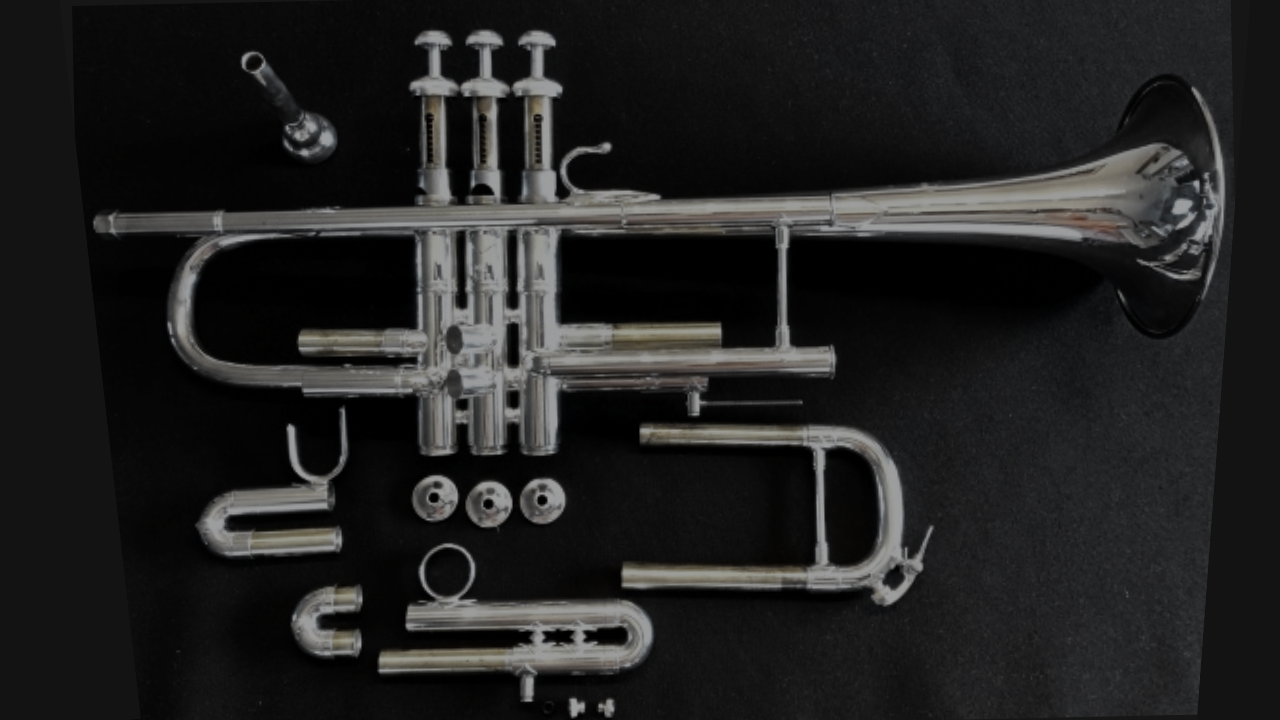

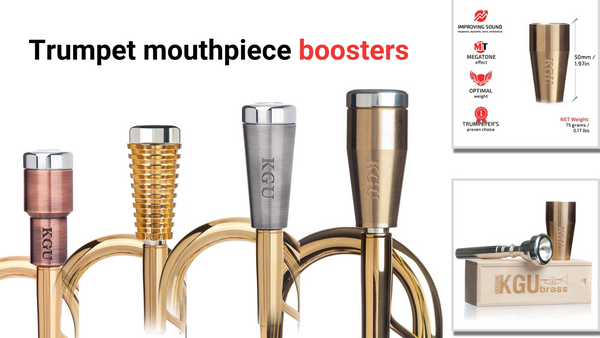

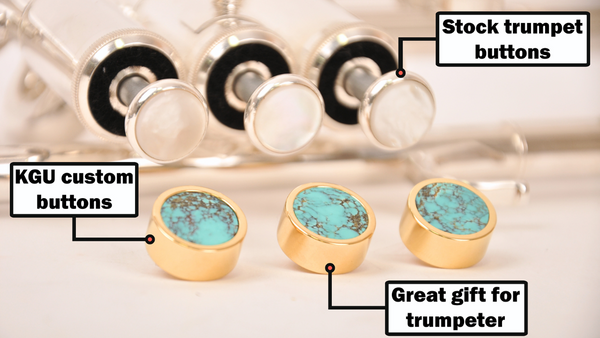

 https://kgumusic.com/collections/trumpets-by-kgumusic
https://kgumusic.com/collections/trumpets-by-kgumusic